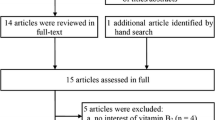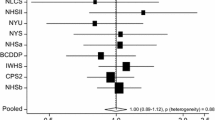Abstract
Objective: The influence of the vitamins A, C, and E on breast cancer development has not been clarified. An effect of a vitamin per se implicates similar patterns for the effects of the vitamin from dietary and supplemental sources. We examined how the breast cancer incidence rate among postmenopausal women was related to intake of vitamins A, C, and E from diet and supplements. Methods: Data was sampled as case–control nested within the Danish ‘Diet, Cancer and Health’ cohort. Data on vitamin intakes were collected at entry into the cohort by means of self-administered questionnaires. Women eligible for the nested case–control study were postmenopausal at entry into the cohort. The analyses were based on 418 cases of incident breast cancer and 394 controls (including two cases). Results: Breast cancer was not significantly related to the intakes of vitamin A or E, whereas a monotonic dose–response relation was seen for the intake of vitamin C. The estimated rate ratio per 100 mg vitamin C was: 2.06 (95% CI: 1.45–2.91) for dietary intake and 1.06 (95% CI: 1.01–1.13) for supplemental intake. Conclusions: We found no evidence of an association between breast cancer and intake of vitamin A or E for postmenopausal women. For vitamin C we found an increase in breast cancer rate with increasing intake.
Similar content being viewed by others
References
Fraga CG, Motchnik PA, Shigenaga MK, Helbock HJ, Jacob RA, Ames BN (1991) Ascorbic acid protects against endogenous oxidative DNA damage in human sperm. Proc Natl Acad Sci USA 88: 11003-11006.
Green MH, Lowe JE, Waugh AP, Aldridge KE, Cole J, Arlett CF (1994) Effect of diet and vitamin C on DNA strand breakage in freshly-isolated human white blood cells. Mutat Res 316: 91-102.
Duthie SJ, Ma A, Ross MA, Collins AR (1996) Antioxidant supplementation decreases oxidative DNA damage in human lymphocytes. Cancer Res 56: 1291-1295.
Panayiotidis M, Collins AR (1997) Ex vivo assessment of lymphocyte antioxidant status using the comet assay. Free Radic Res 27: 533-537.
Shklar G (1998) Mechanisms of cancer inhibition by anti-oxidant nutrients. Oral Oncol 34: 24-29.
Carr AC, Frei B (1999) Toward a new recommended dietary allowance for vitamin C based on antioxidant and health effects in humans. Am J Clin Nutr 69: 1086-1107.
Graham S, Zielezny M, Marshall J, et al. (1992) Diet in the epidemiology of postmenopausal breast cancer in the New York State Cohort. Am J Epidemiol 136: 1327-1337.
Hunter DJ, Manson JE, Colditz GA, et al. (1993) A prospective study of the intake of vitamins C, E, and A and the risk of breast cancer. N Engl J Med 329: 234-240.
Rohan TE, Howe GR, Friedenreich CM, Jain M, Miller AB (1993) Dietary fiber, vitamins A, C, and E, and risk of breast cancer: a cohort study. Cancer Causes Control 4: 29-37.
Kushi LH, Fee RM, Sellers TA, Zheng W, Folsom AR (1996) Intake of vitamins A, C, and E and postmenopausal breast cancer. The Iowa Women's Health Study. Am J Epidemiol 144: 165-174.
Verhoeven DT, Assen N, Goldbohm RA, et al. (1997) Vitamins C and E, retinol, beta-carotene and dietary fibre in relation to breast cancer risk: a prospective cohort study. Br J Cancer 75: 149-155.
Zhang S, Hunter DJ, Forman MR, et al. (1999) Dietary carotenoids and vitamins A, C, and E and risk of breast cancer. J Natl Cancer Inst 91: 547-556.
Michels KB, Holmberg L, Bergkvist L, Ljung H, Bruce A, Wolk A (2001) Dietary antioxidant vitamins, retinol, and breast cancer incidence in a cohort of Swedish women. Int J Cancer 91: 563-567.
Storm HH, Michelsen EV, Clemmensen IH, Pihl J (1997) The Danish Cancer Registry-history, content, quality and use. Dan Med Bull 44: 535-539.
Tjonneland AM, Overvad OK (2000) [Diet, cancer and health-a population study and establishment of a biological bank in Denmark]. Ugeskr Laeger 162: 350-354.
Olsen AV (2000) [Social imbalance in dietary habits. How does the probability vary for living up to diet recommendations with socio economic conditions?] Thesis/Dissertation 1-89. Institute of Human Nutrition, The Royal Veterinary and Agricultural University, Copenhagen.
Overvad K, Tjonneland A, Haraldsdottir J, Ewertz M, Jensen OM (1991) Development of a semiquantitative food frequency questionnaire to assess food, energy and nutrient intake in Denmark. Int J Epidemiol 20: 900-905.
Tjonneland A, Overvad K, Haraldsdottir J, Bang S, Ewertz M, Jensen OM (1991) Validation of a semiquantitative food frequency questionnaire developed in Denmark. Int J Epidemiol 20: 906-912.
Lauritsen J. FoodCalc 1.3. 1998. World Wide Web://www.foodcalc. dk. Computer Program.
Sandström B (1996) Nordiska näringsrekommendationer 1996. Copenhagen: Nord, p. 28.
Barlow WE, Ichikawa L, Rosner D, Izumi S (1999) Analysis of case-cohort designs. J Clin Epidemiol 52: 1165-1172.
Barlow WE (1994) Robust variance estimation for the case-cohort design. Biometrics 50: 1064-1072.
Greenland S (1995) Dose-response and trend analysis in epidemiology: alternatives to categorical analysis. Epidemiology 6: 356-365.
Royston P, Altman DG (1994) Regression using Fractional polynomials of Continuous Covariates: Parsimonious Parametric Modelling. Appl Statist 43: 429-467.
Willett WC (1997) Fat, energy and breast cancer. J Nutr 127: 921S-923S.
Willett W (1998) Nutritional Epidemiology. New York, Oxford: Oxford University Press, p. 3.
Gandini S, Merzenich H, Robertson C, Boyle P (2000) Metaanalysis of studies on breast cancer risk and diet: the role of fruit and vegetable consumption and the intake of associated micronutrients. Eur J Cancer 36: 636-646.
Rose RC, Bode AM (1993) Biology of free radical scavengers: an evaluation of ascorbate. FASEB J 7: 1135-1142.
Carr A, Frei B (1999) Does vitamin C act as a pro-oxidant under physiological conditions? FASEB J 13: 1007-1024.
Young JF, Dragstedt LO, Haraldsdottir J, et al. (2002) Green tea extract only affects markers of oxidative status postprandially: lasting antioxidant effect of flavonoid-free diet. Br J Nutr 87: 343-355.
Young JF, Dragsted LO, Daneshvar B, Lauridsen ST, Hansen M, Sandstrom B (2000) The effect of grape-skin extract on oxidative status. Br J Nutr 84: 505-513.
Smith-Warner SA, Spiegelman D, Yaun SS, et al. (2001) Intake of fruits and vegetables and risk of breast cancer: a pooled analysis of cohort studies. JAMA 285: 769-776.
Author information
Authors and Affiliations
Corresponding author
Rights and permissions
About this article
Cite this article
Nissen, S.B., Tjønneland, A., Stripp, C. et al. Intake of vitamins A, C, and E from diet and supplements and breast cancer in postmenopausal women. Cancer Causes Control 14, 695–704 (2003). https://doi.org/10.1023/A:1026377521890
Issue Date:
DOI: https://doi.org/10.1023/A:1026377521890




